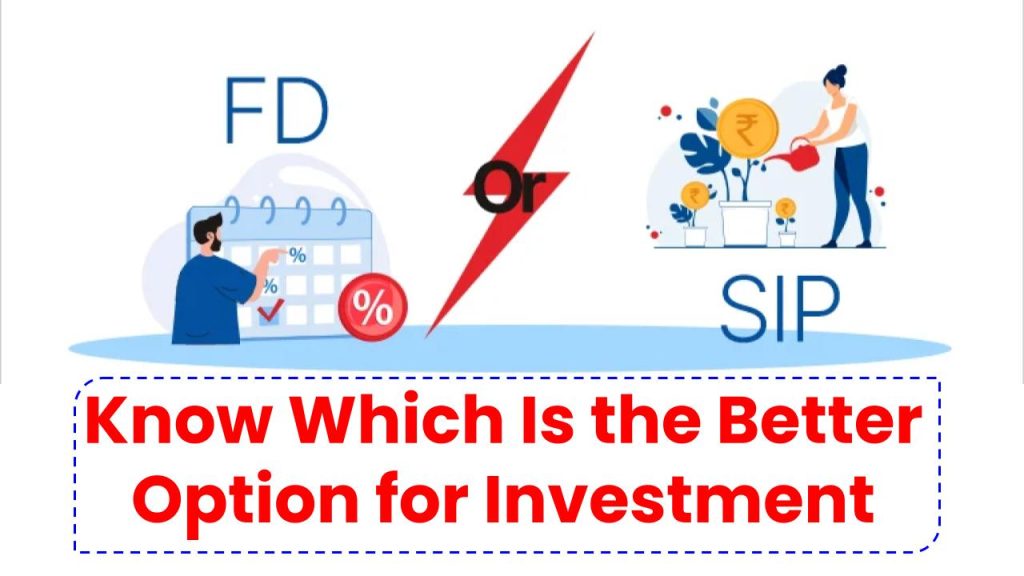
When it comes to choosing between FD vs SIP, most Indian investors find themselves at a crossroads. Should you lock your money away for guaranteed interest or go for a market-linked option that may bring higher returns over time? The answer depends on your financial goals, risk appetite, and investment horizon.
In this guide, we’ll break down the difference between Fixed Deposits (FDs) and Systematic Investment Plans (SIPs) in a way that’s easy to understand for everyone—from beginners to finance professionals. Whether you’re a salaried employee, a retiree, or a young investor just starting out, this article will help you make the right investment choice in 2025.
FD Vs SIP – Which is Better?
| Feature | Fixed Deposit (FD) | Systematic Investment Plan (SIP) |
|---|---|---|
| Returns | 6% to 7.5% p.a. (fixed) | 10% to 15% p.a. (market-linked, not guaranteed) |
| Risk Level | Very low | Moderate to high |
| Investment Type | One-time lump sum | Monthly recurring investments |
| Liquidity | Low; early withdrawal penalty | High; can redeem any time (subject to fund rules) |
| Taxation | Interest taxable as per slab | LTCG/STCG on capital gains (varies by fund type) |
| Ideal For | Conservative investors, short-term goals | Long-term wealth creation, higher risk tolerance |
| Minimum Investment | ₹1,000 (varies by bank) | ₹500 per month (varies by AMC) |
Choosing between FD vs SIP doesn’t have to be a battle. Think of them as two tools in your investment toolkit. If you want peace of mind and capital protection, FDs are your go-to. But if you’re aiming for wealth creation and are okay with some risk, SIPs are the smarter long-term bet.
The best investment strategy often includes both. Play it safe with FDs and grow your future with SIPs. Start small, stay consistent, and let time do its magic.
What is an FD (Fixed Deposit)?
An FD or Fixed Deposit is one of the most popular traditional investment options offered by banks and post offices in India. You deposit a lump sum amount for a fixed tenure—say 1, 3, or 5 years—and earn assured interest on your investment.
Key Features:
- Guaranteed Returns: You know in advance how much you’ll get.
- Tenure Options: From 7 days to 10 years.
- Senior Citizen Benefits: Higher interest rates for people aged 60+.
- Capital Protection: Your principal is safe and not affected by market volatility.
Example:
If you invest ₹1 lakh in an FD offering 7% p.a. for 5 years, your maturity amount will be:
- ₹1,40,255 (with annual compounding).
FDs are regulated by the Reserve Bank of India (RBI), ensuring trust and safety.
see also: This Scheme of Post Office Will Make You Rich
What is an SIP (Systematic Investment Plan)?
An SIP is a way to invest in mutual funds regularly—typically every month. Instead of putting in a large amount at once, you invest small sums (as low as ₹500) periodically. Over time, this allows you to build wealth and benefit from compounding.
Key Features:
- Market-Linked Returns: Higher returns over the long run.
- Rupee Cost Averaging: You buy more units when markets are low and fewer when high, balancing cost.
- Compounding Effect: Your money earns returns, and those returns earn more returns.
- Flexible Investment Horizon: You can start and stop anytime.
Example:
If you invest ₹5,000 per month in an equity mutual fund giving an average return of 12% p.a., here’s what you could earn:
| Duration | Total Invested | Estimated Value |
|---|---|---|
| 5 Years | ₹3,00,000 | ₹4,13,000+ |
| 10 Years | ₹6,00,000 | ₹11,60,000+ |
| 15 Years | ₹9,00,000 | ₹25,30,000+ |
FD Vs SIP: Head-to-Head Comparison
Risk and Safety
- FDs are 100% safe—they’re backed by the bank or post office.
- SIPs involve market risks, especially in equity funds, but historically offer higher returns over time.
Returns
- FDs: 6%–7.5% p.a. (depending on the bank and tenure).
- SIPs: 10%–15% p.a. (based on long-term mutual fund performance).
Tip: For goals like buying a car in 2 years, FDs are better. For retirement or a child’s education in 10+ years, SIPs win.
Investment Flexibility
- FDs require a lump sum. You can’t add more money once you open one.
- SIPs allow flexibility to increase, pause, or stop monthly contributions anytime.
Taxation
- FD interest is fully taxable under your income tax slab.
- SIP gains are taxed as:
- Short-Term Capital Gains (STCG): If redeemed within 1 year — taxed at 15%.
- Long-Term Capital Gains (LTCG): Beyond 1 year — taxed at 10% if gains exceed ₹1 lakh annually.
When Should You Choose an FD?
FD is ideal if you:
- Want guaranteed returns and capital safety.
- Are investing for short-term goals (1–3 years).
- Are a senior citizen looking for assured income.
- Don’t want to take any risks.
Top Banks Offering High FD Rates in 2025:
- SBI: 6.8% – 7.6%
- HDFC Bank: 7% – 7.75%
- Post Office FD: 7.5% (5-year plan)
When Should You Choose SIP?
SIP is ideal if you:
- Are saving for long-term financial goals (5–15 years).
- Want to build wealth through equity or hybrid mutual funds.
- Can handle market ups and downs.
- Prefer low entry amounts (₹500/month).
Top SIP Mutual Fund Categories:
- Large Cap Funds (moderate risk)
- Flexi Cap Funds (flexible across market caps)
- ELSS (Tax Saving Funds) (with 80C tax benefits)
SIP Vs FD – Which is Better in 2025?
Here’s a quick summary:
- For safety and short-term needs → Go for FD.
- For higher growth and long-term goals → Choose SIP.
- For diversification → Consider investing in both: FDs for stability and SIPs for growth.
see also: BOI Revises Fixed Deposit Interest Rates: What You Need to Know
SIP Vs FD FAQs
1. Is SIP safer than FD?
No. FDs are safer because they offer fixed returns. SIPs carry market risk but offer potentially higher returns.
2. Can I lose money in SIP?
Yes, in the short term due to market fluctuations. But over the long term, SIPs have historically given good returns.
3. What is the minimum amount to start SIP or FD?
- SIP: ₹500/month (can vary)
- FD: ₹1,000 or as specified by the bank
4. Which is better for tax saving: FD or SIP?
- Tax-saving FD (5-year lock-in) qualifies under 80C.
- ELSS SIP (3-year lock-in) also qualifies under 80C and offers higher returns.
5. Can I do both SIP and FD together?
Absolutely! Many smart investors do both to balance safety and growth.











